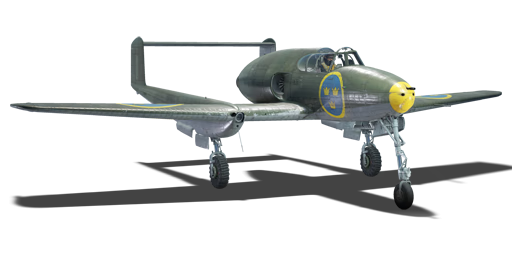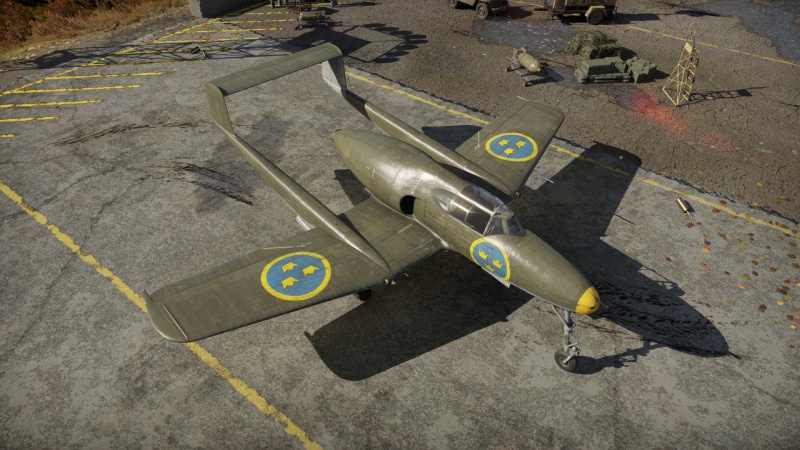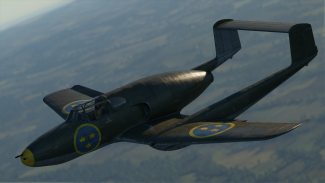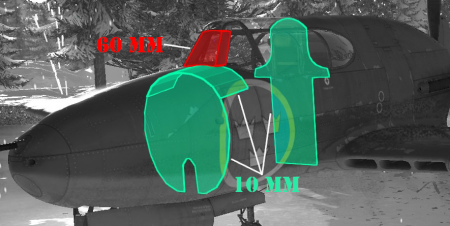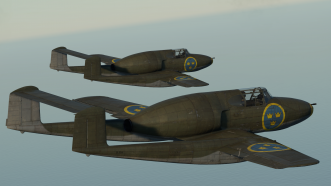Difference between revisions of "J21RA"
Bonisducks (talk | contribs) (→History) (Tag: Visual edit) |
(Added information from A21RB. Added images. Added Usage In Battles) (Tag: Visual edit) |
||
| Line 13: | Line 13: | ||
<!-- ''In the description, the first part should be about the history of and the creation and combat usage of the aircraft, as well as its key features. In the second part, tell the reader about the aircraft in the game. Insert a screenshot of the vehicle, so that if the novice player does not remember the vehicle by name, he will immediately understand what kind of vehicle the article is talking about.'' --> | <!-- ''In the description, the first part should be about the history of and the creation and combat usage of the aircraft, as well as its key features. In the second part, tell the reader about the aircraft in the game. Insert a screenshot of the vehicle, so that if the novice player does not remember the vehicle by name, he will immediately understand what kind of vehicle the article is talking about.'' --> | ||
The '''{{Specs|name}}''' is a rank {{Specs|rank}} Swedish jet fighter {{Battle-rating}}. It was introduced in [[Update 1.95 "Northern Wind"]]. | The '''{{Specs|name}}''' is a rank {{Specs|rank}} Swedish jet fighter {{Battle-rating}}. It was introduced in [[Update 1.95 "Northern Wind"]]. | ||
| + | |||
| + | The {{PAGENAME}} is a jet-powered version of the prior [[J21A-2]], giving it higher speeds and new guns. | ||
== General info == | == General info == | ||
| + | [[File:J21RA Side view .png|left|thumb|325x325px|{{PAGENAME}} as seen from the side.]] | ||
| + | The {{PAGENAME}} is a highly maneuverable plane, with a good climb rate. The guns, although a downgrade from the previous propeller-driven 13 mm version, they still provide enough firepower to down most targets efficiently. The only downside is the airframe, that prevents the aircraft from reaching higher speeds. This is due to the engine being a bit too powerful for the plane, making it common to rip in straight lines and shallow dives. Luckily the {{PAGENAME}} features air-brakes, helping it slow down more effectively, allowing it to fight comfortable at the desired speed range. | ||
| + | |||
| + | The plane is an overall great introduction for anyone looking to learn jet-aircraft, as the vehicle handles very similar to its propeller-driven counterpart, while at a much higher speed than before. | ||
| + | |||
=== Flight performance === | === Flight performance === | ||
<!--''Describe how the aircraft behaves in the air. Speed, manoeuvrability, acceleration and allowable loads - these are the most important characteristics of the vehicle.''--> | <!--''Describe how the aircraft behaves in the air. Speed, manoeuvrability, acceleration and allowable loads - these are the most important characteristics of the vehicle.''--> | ||
| − | {{Specs-Avia-Flight}} | + | {{Specs-Avia-Flight}}The {{PAGENAME}} is distinctly different in looks and performance from all other planes found at the same BR-range. Along with the Yak-15, the Saab 21R is one of the two propeller-driven planes successfully converted into jet propulsion. Just like its Soviet counterpart, the solution comes at the cost of speed. Although a lot more powerful than the J21A-2, it still has the same airframe limitations, resulting in good turn-rate. The climb-rate is also significantly improved due to the weight of the vehicle, resulting in good vertical energy with the ability to stall out slower opponents. Getting back down can prove difficult however, as the {{PAGENAME}} has a rip speed of just 800 km/h, which it can accidentally reach if not careful. To avoid this, the plane features a small set of air-brakes, which aids in maintaining a safe speed. Experienced pilots can find a good use for them, along with the powerful flaps, to force overshoots, or to out-turn propeller-driven opponents. Be careful with the engine however! The propulsion of the {{PAGENAME}} is very primitive, and suffers from fuel starvation during extreme maneuvers, especially in negative G-loads. This can be fatal when fighting vertically, as the engine drops all power almost immediately, and has to spool back up again before reaching the same efficiency as before. |
| + | |||
| + | The flight performance is identical to that of the [[A21RB]], but with slightly less engine power, as the RM1 generates some 130kgf less. | ||
{| class="wikitable" style="text-align:center" width="70%" | {| class="wikitable" style="text-align:center" width="70%" | ||
| Line 117: | Line 126: | ||
* 10 mm steel - Pilot's back armour plate | * 10 mm steel - Pilot's back armour plate | ||
* 60 mm bulletproof glass | * 60 mm bulletproof glass | ||
| + | |||
| + | In terms of protection, the pilot is well protected by metal plates and bulletproof glass. But the pilot's safety isn't the primary concern for the {{PAGENAME}}, as the tail section is incredibly vulnerable. This is due to the twin-boom design, making a tailstrike twice as likely. And since the tail connects to the wing-section, the plane tends to lose tail-control when struck by wing damage. The engine is very large in comparison to the rest of the plane, making it a common target. The {{PAGENAME}} should avoid all possible damage, as surviving large amounts of fire is highly unlikely. Pulling away from head-on engagements increases the survivability immensely. Avoiding the enemy airfield is also important, as the {{PAGENAME}} lacks the speed to keep it safe from flak fire. | ||
=== Modifications and economy === | === Modifications and economy === | ||
| Line 133: | Line 144: | ||
* 2 x 12.7 mm Akan m/39A machine guns, nose-mounted (350 rpg = 750 total) | * 2 x 12.7 mm Akan m/39A machine guns, nose-mounted (350 rpg = 750 total) | ||
* 2 x 12.7 mm Akan m/39A machine guns, wing-mounted (325 rpg = 650 total) | * 2 x 12.7 mm Akan m/39A machine guns, wing-mounted (325 rpg = 650 total) | ||
| + | |||
| + | The {{PAGENAME}} shares the same 20 mm cannon found on the previous J21A-2. This cannon is near identical to the [[Hispano Mk.V (20 mm)|Hispano Mk.V]], only with a 30 rpm lower fire-rate. The shells perform the same as on all the other 20 mm jets, making it highly devastating against all types of aircraft. Armoured targets perform favourably with this cannon, as the air-target belt can cause some mishaps during short bursts. The cannon runs out of ammunition quite quickly compared to the machine-guns, so saving it by only making use of the small calibre guns first can be ideal for spraying. | ||
| + | |||
| + | The {{PAGENAME}} features .50 cal machine guns, being identical to the later American ones. Although a direct downgrade from the Swedish 13 mm previously found on the plane, the {{PAGENAME}} makes good use of these cannons, as they allow for distanced engagements, along with additional firepower to back up the 20 mm cannon. Their ammo count is quite high as well, making them great for strafing, and finishing off heavy bombers. | ||
== Usage in battles == | == Usage in battles == | ||
<!--''Describe the tactics of playing in the aircraft, the features of using aircraft in a team and advice on tactics. Refrain from creating a "guide" - do not impose a single point of view, but instead, give the reader food for thought. Examine the most dangerous enemies and give recommendations on fighting them. If necessary, note the specifics of the game in different modes (AB, RB, SB).''--> | <!--''Describe the tactics of playing in the aircraft, the features of using aircraft in a team and advice on tactics. Refrain from creating a "guide" - do not impose a single point of view, but instead, give the reader food for thought. Examine the most dangerous enemies and give recommendations on fighting them. If necessary, note the specifics of the game in different modes (AB, RB, SB).''--> | ||
| + | * Climb to altitude | ||
| + | * Energy-fight opponents by lowering their speed | ||
| + | * Boom & Zoom people below you | ||
| + | * Dogfight slow targets when necessary | ||
| + | * Fire machine guns and cannons separately to save ammo | ||
| + | |||
| + | [[File:J21RA formation.png|thumb|331x331px|Two {{PAGENAME}} flying in formation.]] | ||
| + | Despite being jet-powered, the {{PAGENAME}} still performs best when played like a propeller driven aircraft. The airplane struggles to reach high speeds, and drops it fairly quickly when maneuvering. So the best use of the new engine is to gain altitude. Although weak in performance compared to earlier jets, the {{PAGENAME}} is decent at climbing to altitude, and can very efficiently deal with targets thanks to the high agility offered at lower speeds. Although the flaps are designed for much lower speeds (similar to the J21A-2), the plane still performs similar to the propeller variant when turning, making them less desired than on other jets. | ||
| + | |||
| + | The best way to start a match is to immediately gain altitude. A height advantage around 5km is usually ideal to avoid losing vital speed when fighting, as the plane can simply dive to gain more velocity. The best way to handle opponents, is to single them out from their team, and forcing them to dogfight, as the {{PAGENAME}} is too slow to chase anyone down. The {{PAGENAME}} is also efficient against propeller aircraft, as it can comfortably turn-fight, while keeping a higher speed. When paired with the devastating firepower it provides, the {{PAGENAME}} becomes deadly when used properly. | ||
| − | + | The {{PAGENAME}} can be used in combined battles (Ground RB & Ground SB), but is overall less efficient compared to the [[A21RB]], as it lacks suspended armaments. | |
=== Pros and cons === | === Pros and cons === | ||
| Line 144: | Line 169: | ||
'''Pros:''' | '''Pros:''' | ||
| − | * Good | + | * Highly maneuverable - Competes with propeller driven aircraft |
| − | * | + | * Familiar layout for seasoned Swede Pilots - Same gun placement as all previous Saab 21's |
| − | + | * Useful air-brakes - Good at avoiding higher speeds | |
| + | * No wing-tanks compared to the [[A21RB]] - Less likely to be set on fire | ||
| + | * Access to modern 12.7mm rounds - Highly efficient at dealing damage | ||
'''Cons:''' | '''Cons:''' | ||
| − | * | + | * Low top speed - Can't reach 800 km/h without tearing off its wings |
| − | * | + | * Downgraded armament - 12.7 mm machine guns instead of the old 13 mm |
| − | * | + | * Small fuel tank with limited fuel choice - Either 21 or 6 minutes of fuel |
| + | * Engine prone to fuel starvation - negative G-load turns the engine off | ||
| + | * Weaker engine compared to the A21RB | ||
== History == | == History == | ||
| Line 165: | Line 194: | ||
== Media == | == Media == | ||
| − | + | <!-- Excellent additions to the article would be video guides, screenshots from the game, and photos. --> | |
<!--;Images | <!--;Images | ||
| Line 176: | Line 205: | ||
;Videos--> | ;Videos--> | ||
| − | |||
| − | |||
| − | + | {{Youtube-gallery|7vSoGWcb5zs|The Swedish Jet No Ones Talking About - War Thunder 1.95|JZcfQqbYWQk|Slap a Jet Engine on a Prop? J21RA - Sweden - War Thunder Review!}} | |
| − | + | ||
| − | <!--;Related development | + | == See also ==<!-- Links to the articles on the War Thunder Wiki that you think will be useful for the reader, for example: |
| + | |||
| + | reference to the series of the aircraft; | ||
| + | links to approximate analogues of other nations and research trees. --><!--;Related development | ||
* [[?-?? (Family)]] | * [[?-?? (Family)]] | ||
| Line 187: | Line 217: | ||
* Airplane manufacture name [[Airplane name]]--> | * Airplane manufacture name [[Airplane name]]--> | ||
| + | '''Similar Swedish aircraft''' | ||
| + | |||
| + | * [[J21 (Family)]] | ||
| + | * [[J28B]] | ||
| + | * [[SK60B]] | ||
| + | |||
| + | '''Comparable Aircraft''' | ||
| + | |||
| + | * [[Yak-15]] | ||
| + | * [[F-80A-5]] | ||
| + | * [[He 162 (Family)]] | ||
== External links == | == External links == | ||
Revision as of 19:29, 14 July 2021
| This page is about the Swedish jet fighter J21RA. For other versions, see J21 (Family). |
Contents
Description
The J21RA is a rank V Swedish jet fighter with a battle rating of 6.7 (AB/RB/SB). It was introduced in Update 1.95 "Northern Wind".
The J21RA is a jet-powered version of the prior J21A-2, giving it higher speeds and new guns.
General info
The J21RA is a highly maneuverable plane, with a good climb rate. The guns, although a downgrade from the previous propeller-driven 13 mm version, they still provide enough firepower to down most targets efficiently. The only downside is the airframe, that prevents the aircraft from reaching higher speeds. This is due to the engine being a bit too powerful for the plane, making it common to rip in straight lines and shallow dives. Luckily the J21RA features air-brakes, helping it slow down more effectively, allowing it to fight comfortable at the desired speed range.
The plane is an overall great introduction for anyone looking to learn jet-aircraft, as the vehicle handles very similar to its propeller-driven counterpart, while at a much higher speed than before.
Flight performance
The flight performance is identical to that of the A21RB, but with slightly less engine power, as the RM1 generates some 130kgf less.
| Characteristics | Max Speed (km/h at 4,000 m) |
Max altitude (metres) |
Turn time (seconds) |
Rate of climb (metres/second) |
Take-off run (metres) | |||
|---|---|---|---|---|---|---|---|---|
| AB | RB | AB | RB | AB | RB | |||
| Stock | 763 | 744 | 12192 | 25.1 | 25.9 | 18.0 | 17.3 | 850 |
| Upgraded | 836 | 799 | 23.0 | 24.0 | 24.4 | 21.0 | ||
Details
| Features | |||||
|---|---|---|---|---|---|
| Combat flaps | Take-off flaps | Landing flaps | Air brakes | Arrestor gear | Drogue chute |
| ✓ | ✓ | ✓ | ✓ | X | X |
| Limits | ||||||
|---|---|---|---|---|---|---|
| Wings (km/h) | Gear (km/h) | Flaps (km/h) | Max Static G | |||
| Combat | Take-off | Landing | + | - | ||
| 787 | 360 | 437 | 408 | 260 | ~11 | ~5 |
| Optimal velocities (km/h) | |||
|---|---|---|---|
| Ailerons | Rudder | Elevators | Radiator |
| < 450 | < 390 | < 420 | N/A |
Engine performance
| Engine | Aircraft mass | |||||
|---|---|---|---|---|---|---|
| Engine name | Number | Empty mass | Wing loading (full fuel) | |||
| Svenska Flygmotor RM1 | 1 | 3,420 kg | 188 kg/m2 | |||
| Engine characteristics | Mass with fuel (no weapons load) | Max Takeoff Weight | ||||
| Weight (each) | Type | 6m fuel | 20m fuel | 22m fuel | ||
| 705 kg | Centrifugal-flow turbojet | 3,654 kg | 4,107 kg | 4,172 kg | 5,000 kg | |
| Maximum engine thrust @ 0 m (RB / SB) | Thrust to weight ratio @ 0 m (100%) | |||||
| Condition | 100% | WEP | 6m fuel | 20m fuel | 22m fuel | MTOW |
| Stationary | 1,290 kgf | N/A | 0.35 | 0.31 | 0.31 | 0.26 |
| Optimal | 1,290 kgf (0 km/h) |
N/A | 0.35 | 0.31 | 0.31 | 0.26 |
Survivability and armour
- 10 mm steel - Firewall armour plate
- 10 mm steel - Firewall cover armour plate
- 10 mm steel - Pilot's back armour plate
- 60 mm bulletproof glass
In terms of protection, the pilot is well protected by metal plates and bulletproof glass. But the pilot's safety isn't the primary concern for the J21RA, as the tail section is incredibly vulnerable. This is due to the twin-boom design, making a tailstrike twice as likely. And since the tail connects to the wing-section, the plane tends to lose tail-control when struck by wing damage. The engine is very large in comparison to the rest of the plane, making it a common target. The J21RA should avoid all possible damage, as surviving large amounts of fire is highly unlikely. Pulling away from head-on engagements increases the survivability immensely. Avoiding the enemy airfield is also important, as the J21RA lacks the speed to keep it safe from flak fire.
Modifications and economy
Armaments
Offensive armament
The J21RA is armed with:
- 1 x 20 mm Akan m/45 cannon, nose-mounted (140 rpg)
- 2 x 12.7 mm Akan m/39A machine guns, nose-mounted (350 rpg = 750 total)
- 2 x 12.7 mm Akan m/39A machine guns, wing-mounted (325 rpg = 650 total)
The J21RA shares the same 20 mm cannon found on the previous J21A-2. This cannon is near identical to the Hispano Mk.V, only with a 30 rpm lower fire-rate. The shells perform the same as on all the other 20 mm jets, making it highly devastating against all types of aircraft. Armoured targets perform favourably with this cannon, as the air-target belt can cause some mishaps during short bursts. The cannon runs out of ammunition quite quickly compared to the machine-guns, so saving it by only making use of the small calibre guns first can be ideal for spraying.
The J21RA features .50 cal machine guns, being identical to the later American ones. Although a direct downgrade from the Swedish 13 mm previously found on the plane, the J21RA makes good use of these cannons, as they allow for distanced engagements, along with additional firepower to back up the 20 mm cannon. Their ammo count is quite high as well, making them great for strafing, and finishing off heavy bombers.
Usage in battles
- Climb to altitude
- Energy-fight opponents by lowering their speed
- Boom & Zoom people below you
- Dogfight slow targets when necessary
- Fire machine guns and cannons separately to save ammo
Despite being jet-powered, the J21RA still performs best when played like a propeller driven aircraft. The airplane struggles to reach high speeds, and drops it fairly quickly when maneuvering. So the best use of the new engine is to gain altitude. Although weak in performance compared to earlier jets, the J21RA is decent at climbing to altitude, and can very efficiently deal with targets thanks to the high agility offered at lower speeds. Although the flaps are designed for much lower speeds (similar to the J21A-2), the plane still performs similar to the propeller variant when turning, making them less desired than on other jets.
The best way to start a match is to immediately gain altitude. A height advantage around 5km is usually ideal to avoid losing vital speed when fighting, as the plane can simply dive to gain more velocity. The best way to handle opponents, is to single them out from their team, and forcing them to dogfight, as the J21RA is too slow to chase anyone down. The J21RA is also efficient against propeller aircraft, as it can comfortably turn-fight, while keeping a higher speed. When paired with the devastating firepower it provides, the J21RA becomes deadly when used properly.
The J21RA can be used in combined battles (Ground RB & Ground SB), but is overall less efficient compared to the A21RB, as it lacks suspended armaments.
Pros and cons
Pros:
- Highly maneuverable - Competes with propeller driven aircraft
- Familiar layout for seasoned Swede Pilots - Same gun placement as all previous Saab 21's
- Useful air-brakes - Good at avoiding higher speeds
- No wing-tanks compared to the A21RB - Less likely to be set on fire
- Access to modern 12.7mm rounds - Highly efficient at dealing damage
Cons:
- Low top speed - Can't reach 800 km/h without tearing off its wings
- Downgraded armament - 12.7 mm machine guns instead of the old 13 mm
- Small fuel tank with limited fuel choice - Either 21 or 6 minutes of fuel
- Engine prone to fuel starvation - negative G-load turns the engine off
- Weaker engine compared to the A21RB
History
The J21RA is a variant of the Saab 21R, a unique early jet fighter developed from the previous Saab 21. The aircraft was one of two semi-successful conversions of propeller fighters into jet fighters, the other being the Soviet Yak-15 (which was converted from the Yak 1/3/7/9 series). The aircraft served as one of the first jet-engined aircraft in Swedish service and was also the first jet-engined-aircraft produced by Saab. The Saab 21Rs were retired in the 1950s with the introduction of more advanced Swedish aircraft.
During WWII, the Saab aircraft production company produced the Saab 21, a fighter aircraft with an unorthodox twin-boom configuration along with a German DB 605B engine. The first such aircraft flew in July of 1943 and entered service soon thereafter. During this time, the Saab firm explored various options for upgrading their Saab 21s, including a variant powered by a Rolls-Royce Griffon engine producing 2000 hp. However, at the same time, the Saab firm was also investigating the possibility of a jet-engined fighter; this led the Saab firm to pursue a jet-engined variant of the Saab 21 for use with the Swedish air force.
In 1947, Saab received the first older J21 airframes for conversion into a jet fighter, designated the J21R; the airframes were extensively modified to house a British-sourced De Havilland Goblin turbojet in place of the DB 605 and its corresponding propeller. Extensive modifications were also made to the aircraft’s fuselage, wings and tailplane; notably, the tail section was redesigned so that the elevator would be clear of the jet engine’s exhaust. Additionally, the aircraft featured an ejection seat, a novelty at the time.
Initially, a production run of 124 aircraft was planned; however, this was cut to 64 aircraft when the more-advanced J29 Tunnan became available in 1948. The J21RA was the designation given to the first 34 of these aircraft, powered by the Goblin 2 engine, while the J21RB was powered by an indigenously-built Goblin 3 engine. The J21 was retired in the mid-1950s with the introduction of more advanced aircraft such as the Saab 32 Lansen; no original aircraft were preserved but an old Saab 21 airframe was converted to resemble the Saab 21R; this aircraft is displayed at the Swedish Air Force Museum.
Media
See also
Similar Swedish aircraft
Comparable Aircraft
External links
| Swedish Aeroplane Company Ltd. (SAAB) | |
|---|---|
| Pre-SAAB: SA / ASJA | |
| SA 'Jaktfalken' | J6B |
| SAAB 17 | B17A · B17B · S17BS |
| SAAB 18 | B18A · B18B · T18B · T18B (57) |
| SAAB 21 | J21A-1 · J21A-2 · A21A-3 · J21RA · A21RB |
| SAAB 29 'Tunnan' | J29A · A29B · J29D · J29F |
| SAAB 32 'Lansen' | J32B · A32A · A32A Röd Adam |
| SAAB 35 'Draken' | J35A · J35D |
| SAAB 37 'Viggen' | JA37C · JA37D · JA37DI · JA37DI F21 · AJ37 · AJS37 |
| SAAB 39 'Gripen' | JAS39A · JAS39C |
| SAAB 105 | SK60B · SAAB-105G |
| License Production | B3C (Ju 86K) |
| Export | SAAB-105OE · J35XS · ▄JAS39C · ◔JAS39EBS HU C |
| Sweden jet aircraft | |
|---|---|
| Fighters | J21RA |
| J29A · A29B · J29D · J29F | |
| J32B | |
| J34 | |
| J35A · J35D | |
| JA37C · JA37D · JA37DI · JA37DI F21 | |
| JAS39A · JAS39C | |
| Strike aircraft | A21RB |
| A32A · A32A Röd Adam | |
| A28B | |
| AJ37 · AJS37 | |
| SK60B · SAAB-105G | |
| Export | SAAB-105OE |
| Finland | ▄Vampire FB 52A · ▄MiG-21bis · Saab J35XS |


